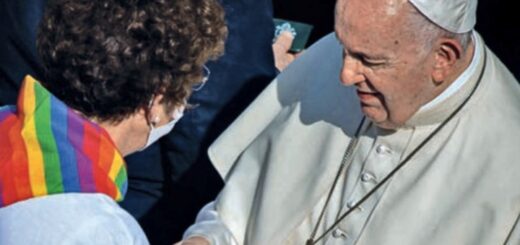Homosexuality. Origin and spread of a new social identity
 Scientific article by the psychiatrist Patricia H Bazemore md., Coautori: William H Wilson MD, Douglas a Bigelow, published on emedicine.com of 28 May 2008, freely translated by Francis
Scientific article by the psychiatrist Patricia H Bazemore md., Coautori: William H Wilson MD, Douglas a Bigelow, published on emedicine.com of 28 May 2008, freely translated by Francis
The prevalence and incidence of homosexuality has been intensely studied (Michaels, 1996) but the data available remain limited for two methodological difficulties. First of all, the definition of homosexuality.
An uncertain estimate of the number and distribution of homosexuality stands around 10%. The estimate derives from Kinsey's random pioneering.
The problem is that they were based on a sample of selected people and not on a randomly chosen sample of the general population. The usefulness of these studies is greater to seek correlations with other parameters within the same group rather than to infer general information.
Kinsey's studies have contributed to the understanding of the dimensional nature of homosexuality through the gradation of homosexual and heterosexual experiences on a scale from 0 to 6 (by exclusively heterosexual at exclusively homosexual). Kinsey reported that males and females of this chosen champion of people were distributed on all the values of the scale and only a minority of the interviewees declared that he had or had only homosexual experiences.
More recently, some studies have tried to define the frequency of homosexuality in the general population. The Case of the National Health and Social Life, 1992, used a mutidimensional frame that takes into account the sexual behavior, desire and identity (Laumann, 1994).
About 10% of males and 5% of females had homosexual contacts starting from adolescence and respectively 5% of males and 4% of females had homosexual experiences from the age of 18.
The validity of these estimates has been questioned for methodological issues but the fact remains that this case produces results that echo closely those of Kinsey and that show how sexuality is a complex and fluid dimension without a clear distinction between homosexual and heterosexual person.
The 2000 American census provided valuable information regarding the composition of families in the United States (US census Bureau, 2001). It indicates that there are at least 500,000 couples belonging to the same sex and this figure is intended to rise by 10-20%. It seems that about 0.5% of Americans live in a relationship with a patner of the same sex.
The most important conclusion of this census is that the homosexual population is large enough to be examined in the programming of the country's health plans.
causes
The phenomenon of homosexuality is complex and the factors involved in the genesis of homosexuality are manifold. As with epidemiological surveys, the study of the causes of homosexuality is also made difficult by the lack of a clear definition of homosexuality as well as by the overlap of homosexuality and heterosexuality.
The serious discussion on the causes of homosexuality is also often complicated by the presence of simplistic notions that are taken from the various parts of the debate from time to time to support their political, cultural and religious point of view (Stein, 1996). The family's biopsicosocial model is a useful model for organizing our current knowledge on the causes of homosexuality.
Biological factors
Evolutionistic theory is, perhaps, the most elementary level of biological thought on homosexuality. Evolutionists struggle to explain why homosexuality is so rooted in human biological behavior. A negative evolutionary pressure towards homosexuality already exists when it is thought that homosexual people have, certainly, less children than heterosexual ones.
A current answer to this question derives from the observation that human communities with homosexual members have specific survival characteristics (Kirkpatrick, 2000; Muscarella, 2000).
The advantage can be linked to the fact that, in these groups, there are more workers, which allow others to take care of the offspring more. However, every evolutionary theory on homosexuality is purely speculative.
Homosexual relationships are also found in the animal world
The maternal immunization theory of postulate homosexuality that sexual orientation is more likely in men who have older brothers. The probability would be greater as to increase the number of brothers.
Maternal immunization means some molecular-genetic modification that would happen in the mother against the male fetus and whose probability increases with the increase in pregnancy of male fetuses (Blanchard, 2001).
The mother's immune system in response to our older brothers, for those who have it, would make us become gay by acting in some way on our molecules.
The biological bases of the physical attraction based on Ferormoni (substances that evoke odorous sensations), smells etc. It is known in many animal species. In men the signals transmitted by the smells are often thin and unconscious given the low weight of the conscious communication mediated by the smell (Kohl, 2001). A recent study analyzed the attraction mediated by Ferormoni in heterosexual and homosexual subjects (Martins, 2005).
In a study in which he obliged himself to choose, the smells of homosexual males were the least favorite except among the gay males who preferred the smells of other gay males or heterosexual females.
Both the hetero-homo-sexual females preferred the smells of heterosexual individuals of the other sex to those of male or female homosexual subjects. Heterosexual males preferred heterosexual males and females. Ferormoni could be related to the bogical bases of the different sexual orientation (Ober, 1997).
Other studies have led to an association between histocompatibility antigens (molecules that characterize our immune system, our interface with the outside world) and sexual orientation.
Prenatal hormones and chemicals have been studied as potential factors that contribute to determining homosexual orientation. An increase in spatial skills (cognitive functions used in the processing of the internal and external space) have been associated with the prenatal exposure to androgens.
A recent study has shown a strong correlation between homosexual behavior and space skills in women before menopause, thus implying an association between sexual behavior and prenatal exposure to androgens.
Another study has shown a greater frequency of homosexual females among the daughters of women who had used slimming drugs based on amphetamine or synthetic thyroid hormones (Ellis, 2005). Nicotine exposure also seems to be an important element in the development of female homosexuality in animal models (Ellis, 2001).
Physiological explanations of homosexuality have been sought, but there is no definitive one (Byne, 1996). Genetic factors can play a role but there is no final test.
There is no evidence of heredity. The standard genetic study models have been applied, including the analysis of the pedigree, the study of homozygous twins the molecular genetics of linkage (association of different genetic traits together).
Studies on homozygous twins (identical from a genetic point of view) show a higher concordance in terms of homosexuality than heterozygous twins. Among identical twins, the percentages of concordance (expression of the same character) are reported in the order of 48-60%, which certainly indicates a role of genetic factors, even if they do not completely explain the expression of homosexuality.
Molecular association studies have suggested that some chromosomal regions may be involved in giving a predisposition to homosexuality (example XQ28), but a specific gene has not been identified.
The hormonal environment in which the fetus develops clearly influences sexual anatomy and behavior. For example, prenatal androgens are necessary for the development of the male external genitalia in genetically male fetuses.
In animals, a series of consequences deriving from intrauterine hormonal manipulation is described. For example, female rats, exposed to increased levels of androgenic hormones during fetal development, show sexual behaviors typical of males in adult life. Probably, hormonal, genetic and biological factors influence behavior by determining structural and functional modifications of the brain (Byne, 1996).
In rodents, morphological differences in the brain are linked to different exposure to hormones in fetal life. Equally clear differences have not been demonstrated in humans. The regions of the human brain implicated in the expression of homosexuality are the interstitial nuclei of the front hypothalamus, the non -firm core, the front commissioner, and the callful body. Various studies, however, arrive at heterogeneous results.
There is no consensus regarding the existence of a homosexual brain, that is, morphologically and physiologically characteristic of the homosexual being. In conclusion, the two -way factors exert an influence in the cognitive and emotional processes that contribute to forming the character, the intensity of sexual need, the desire for safety towards that of adventure and similar personality traits.
These characteristics influence the way in which the individual reacts to social stimuli and can influence his choices. Supporters of the decisive importance of biological factors may think that they deeply influence sexual orientation, but do not have sufficient data, at the moment, to say what their contribution is to determine it.
Psychological factors
In the first adolescence, most people have an already clear internal sense of their sexual orientation. However, the expression of their sexuality is strongly influenced by the sexual behaviors they observe in the environment in which they live and by the opportunities they present themselves.
The data of the National Health and Social Life They suggest that during adolescence the behaviors and experiences of "test" with various sexual options reach a peak. The individual would experience with the various possibilities of sexuality. With the continuation of development, personal identity strengthens and the choices of the patner, of sexual behavior are more consistent.
Psychoanalytic theories deal with the development of desire and sexual identity in a various way and with different approaches, attributing a lot of weight to family matrices and relational contexts in which the individual lives and has experienced, with the goal often to reach a mature awareness of themselves.
Social factors
While biological factors condition sexual preferences, the social ones have heavily affect the choices. Anthropological studies show that in some societies homosexual behavior has been accepted in all aspects of daily life, but in others it has been considered as a dangerous moral deviation and, therefore, also punishable with death (Herdt, 1996).
Therefore, the expression of homosexuality also varies in relation to the social context. In the western world, there is a strong pressure to present itself in terms of sexual orientation.
Everyone is expected to have a precise identity and posters publicly. Sometimes a sort of sexual identity is attributed by the group in which the subject lives before even that he himself is fully aware of himself.
When the subjects choose a homosexual social identity cross the ritual of the coming out, the coming out, the proclamation of themselves. The process begins through the recognition of one's sexual identity, passes through the affirmation of one's identity and ends with the public declaration of being homosexuals.
Like many ritual passages, that of coming out can be easy, but more often it is particularly traumatic from an emotional and behavioral point of view, it can lead to strong frictions in the family and social context of the person. Many subjects prefer to keep their homosexuality hidden to avoid social complaints and penalties.
Original text: Homosexuality






